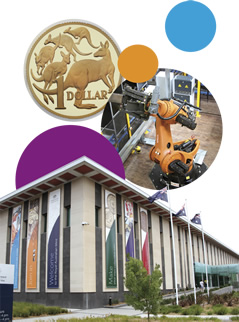The Royal Australian Mint produces all the coins we spend in Australia.
A printable PDF of the information on this page is available in the right-hand column.
The Royal Australian Mint

The Royal Australian Mint is in Canberra and was officially opened on 22 February 1965. All the coins you have in your pocket, purse or piggy bank are made at the Mint.
Before 1966 Australia used pounds, shillings and pence which were based on the British currency. On 14 February 1966, Australia changed to the dollars and cents we use now. When the Mint opened, its first job was to start making the new Australian coins.
Since 1966 the Mint has made over 14 billion coins and can produce two million every day. Wow, that is a lot of coins!
The Mint not only makes Australian coins but also produces coins for other countries and makes medals, medallions, tokens and commemorative coins.
Australian coins
All the Australian coins you have in your pocket, purse or piggy bank are made at the Royal Australian Mint in Canberra. Every coin has two sides: the ‘heads’ side (sometimes called the ‘obverse’ side) and the ‘tails’ side (sometimes called the ‘reverse’ side).
The heads (obverse) side of the coin will always have a picture of the monarch on it. Today that is Queen Elizabeth II. This side will also have the word ‘Australia’ and the year the coin was made printed on it.
The tails (reverse) side has a picture of something very Australian and is different for each coin.
- The five cent coin has a picture of an echidna.
- The ten cent coin has a picture of a lyrebird.
- The twenty cent coin has a picture of a platypus.
- The fifty cent coin has a picture of the Commonwealth Coat of Arms.
- The one dollar coin has a picture of five kangaroos.
- The two dollar coin has a picture of a traditional Australian Aboriginal man and the Southern Cross.
Sometimes the Mint will make coins that celebrate special events or people. These coins will have a different picture on the tails side and are called commemorative coins.
Did you know that the one and two dollar coins are not as old as the other coins? We started using the one dollar coin in 1984 and the two dollar coin in 1988. Before that we had a one dollar note and a two dollar note, but notes do not last as long as coins and cannot be used in coin-operated machines. If you ask an adult they may have an old one or two dollar note for you to look at.
Have you ever seen a one or two cent coin? Both of these were used until 1992, but now our lowest-value coin is the five cent coin.
Royal Australian Mint fast facts
- At the Royal Australian Mint there is a staircase filled with five cent coins. It looks amazing.
- If you live in Canberra, or are visiting, you can visit the Mint and see coins being made. You can also make your own coin to take home.
- The Mint does not make Australian notes. All our notes are printed in Victoria by a company called Note Printing Australia.
- Australian coins that have a bumpy edge are called ‘milled’ coins. Can you work out which ones are the milled coins? (Hint: there is only one coin that is not milled.)
- Which coin do you think weighs the most? It is the fifty cent coin, and the five cent coin is the lightest.
- Until 1969 the fifty cent coin was round! Now it has twelve sides.
- Did you know that our gold coins are not really made of gold and our silver coins are not made from silver? The gold coins are made from copper, aluminium and nickel and the silver coins are made from copper and nickel. This is because these metals cost less than gold or silver.
- You cannot tell the value of a coin by looking at its size. The two dollar coin is smaller than the one dollar coin, the fifty cent coin and the ten cent coin, but is worth more than each of them and all of them added together!





